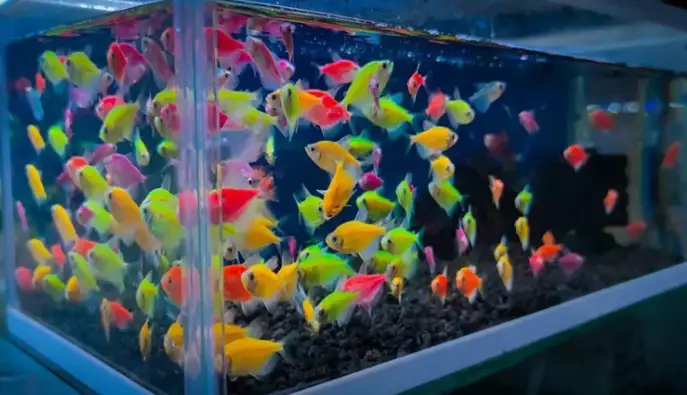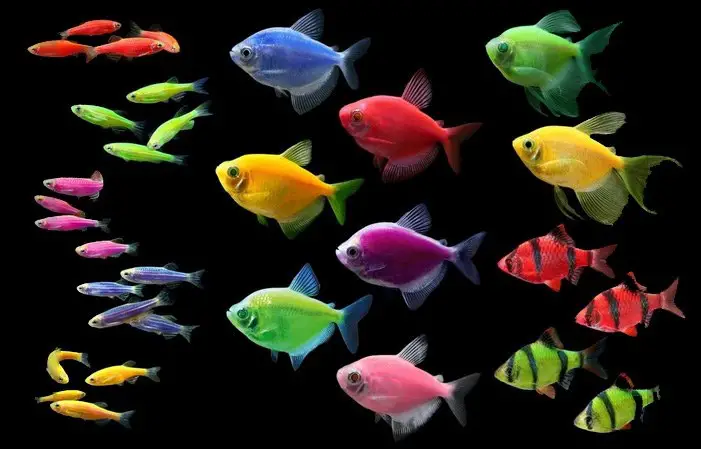In the fascinating realm of aquariums, GloFish have captured the attention of enthusiasts and hobbyists with their vibrant and captivating colors.
As these dazzling fish glide through the water, their radiant hues evoke awe and curiosity.
However, amid the allure of their neon-like shades, a question often arises: Are GloFish dyed to achieve their eye-catching colors?
In this exploration, we delve into the science behind GloFish’s coloration, dispelling myths and unveiling the truth about their appearance.
The History of GloFish Development

The history of GloFish development is a fascinating tale that combines science, art, and ethics. It all started in the 1990s when scientists from the National University of Singapore successfully inserted a jellyfish gene into zebrafish embryos, causing them to exhibit fluorescent colors. This breakthrough discovery opened up new possibilities for genetic modification and led to the birth of the first-ever GloFish.
Soon after their creation, GloFish faced numerous legal and ethical challenges. The U.S. Food and Drug Administration questioned whether these genetically modified pets should be considered a regulated animal drug due to concerns about their potential impact on ecosystems if released into the wild. Eventually, in 2003, after years of deliberation and discussions with regulatory agencies, Yorktown Technologies succeeded in bringing GloFish to market as ornamental fish, marking a significant milestone in the history of biotechnology.
Today, while some may view GloFish as novelty pets used purely for aesthetic purposes, others see them as an embodiment of scientific progress and artistic expression merged into one mesmerizing creature swimming in our living rooms—an example where biotechnology meets beauty.
With their vibrant colors illuminating aquariums worldwide, it’s hard not to be captivated by the journey behind the development of these unique creatures known as GloFish. From scientific breakthroughs to ethical debates surrounding genetic modification and animal welfare considerations—all contribute to shaping this captivating story at the intersection of science fiction becoming reality.
Are Glofish Dyed? (Everything You Need to Know)
Glofish, with their vibrant and dazzling colors, have become quite the eye-catcher in the world of aquarium enthusiasts. However, a common misconception surrounding these unique fish is that they are dyed artificially to enhance their pigmentation. Contrary to popular belief, glofish are not dyed; instead, they owe their fluorescent hues to a process known as genetic modification.
By inserting genes from jellyfish and coral into zebrafish embryos, scientists were able to create this stunning display of colors. This cutting-edge genetic engineering technique allows the fish to produce naturally occurring fluorescent proteins that give them their radiant appearance. In fact, without the use of dyes or artificial additives, glofish can exhibit such awe-inspiring shades as Electric Green and Sunburst Orange.
Genetic modification offers a whole new realm of possibilities for aquarists who crave an otherworldly aquatic experience. With glofish at the forefront of this innovation, one can only imagine what future advancements in genetics could bring to our aquariums. While some may still hold reservations about genetically modified organisms (GMOs), it’s essential to recognize that these creatures offer us a glimpse into the boundless potential of science and its impact on our natural world.
Understanding Dyeing in Aquarium Fish

Dyeing, a controversial practice in the aquarium industry, involves injecting fish with colored dyes to alter their appearance. While some may view this as harmless fun or an opportunity for artistic expression, it is crucial to recognize the potential harm and ethical concerns associated with dyeing fish.
Firstly, the process of injecting dyes into fish can cause significant stress and discomfort. These injections are not only painful but also increase the risk of infection or even death. Additionally, dyed fish may experience physical and psychological damage as their altered appearance can have negative consequences on their social interactions within the aquarium community.
Moreover, it is important to question why we feel the need to artificially change the coloration of aquarium fish. Nature has already endowed these creatures with magnificent colors and patterns that serve various purposes such as camouflage or attracting mates. By artificially dyeing them, we undermine nature’s beauty and disrupt the intricate balance that exists in aquatic ecosystems.
Understanding dyeing in aquarium fish goes beyond mere curiosity about how it is done; it entails recognizing both its potential harm to individual species and its broader implications for environmental stewardship. Instead of altering natural beauty through artificial means, let us appreciate and protect these stunning creatures for what they naturally are – a testament to nature’s creativity and diversity within our underwater world.
Difference Between Dyeing and Genetic Modification in Glofish
Glofish, the vibrant and colorful fish that have taken the pet industry by storm, often leave onlookers mesmerized. However, it is crucial to understand that not all Glofish get their brilliant hues through the same means. Some may be genetically modified, while others are simply dyed.
Genetic modification involves altering the genetic makeup of an organism to introduce specific traits. In the case of Glofish, scientists insert a fluorescent protein gene into their DNA using a process called transgenesis. This genetically modified trait is then passed on to future generations. On the other hand, dyeing involves temporarily staining or coloring the fish using non-toxic dyes. The dye only affects their external appearance and does not alter their DNA.
It’s important to note that there is ongoing debate about these practices within the aquarist community and among animal welfare organizations. While some argue that genetic modification can lead to improved scientific research or medical advancements, others highlight concerns regarding potential risks or ethical implications. Similarly, dyeing raises questions about how it may affect a fish’s well-being in terms of stress levels or long-term health effects.
Differentiating between dyed and genetically modified Glofish requires understanding both methods’ underlying processes and potential consequences. This knowledge empowers consumers to make informed choices when bringing these captivating creatures into their homes and ensures responsible decision-making in supporting sustainable practices within the pet industry as a whole.
The Benefits of Genetic Modification in Glofish
Genetic modification in GloFish offers several advantages beyond aesthetics. These fish serve as valuable tools in scientific research and education. By introducing specific genetic traits, scientists are able to study the effects of certain genes on the fish’s behavior, development, and physiology. This research not only enhances our understanding of genetics but also has potential implications for human health.
One of the main benefits of genetic modification in GloFish is their use in environmental monitoring. These fluorescent fish can act as bioindicators, providing real-time information about water quality and pollution levels. For example, if a certain toxin is present in a body of water, the fluorescence of GloFish may change or become more pronounced. By simply observing the glowing patterns of these fish, scientists can quickly identify potential environmental hazards and take necessary actions to protect both aquatic ecosystems and human populations.
Moreover, genetic modification allows for disease resistance enhancement in GloFish. Through genetic engineering techniques, it is possible to introduce genes that provide immunity against common fish diseases such as white spot syndrome virus or bacterial infections. By developing genetically modified GloFish that are resistant to various pathogens, aquaculture industries can minimize economic losses associated with disease outbreaks while reducing the need for harmful antibiotics or chemicals.
While GloFish have undoubtedly captivated people around the world with their vibrant colors and unique appearance, their benefits extend far beyond aesthetics alone.
Are Glofish Gyed? (Summary)
Despite their vibrant colors, glofish are not dyed. They are genetically modified organisms that have been altered to express fluorescent proteins. This process involves inserting genes from other species into the fish’s DNA, allowing them to produce these striking hues. While some may argue that this modification is unnatural and unethical, others see it as a harmless way to enhance visual appeal. Regardless of personal opinions, it is important for consumers to be aware of the true nature of glofish and make informed decisions when purchasing pets. By educating ourselves about the processes behind genetically modified organisms like glofish, we can make more responsible choices in supporting the pet industry.
Other Blog Posts